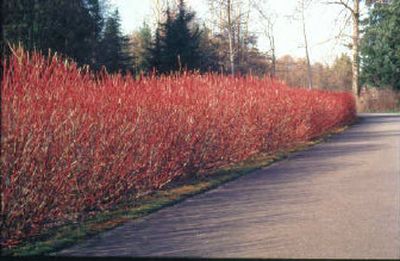A winter red plant

Native Plant of the Month for February: red-osier dogwood (cornus sericea, a.k.a. cornus stolonifera)
Why it’s choice: This fast-growing shrub pleases every month of the year. During dark winter days, its red twigs glow under sunny or gray skies. Leafing out, the shrub forms a fresh green backdrop to its own clusters of creamy-white flowers and to other spring-bloomers.
Red-osier dogwood will often bloom into late fall, so that you can see it with both flowers and its blue-white berries when the leaves turn yellow or maroon.
What it can do in the garden: Red-osier dogwood forms bird-friendly thickets – watch for flickers and warblers in its branches. Orange sulphur butterflies may be found drinking the flowers’ nectar. This shrub loves moist to wet soil and the banks of salmon streams. Its ability to spread underground makes it a great choice for erosion control. In a garden setting, suckers are to be expected but can be controlled.
To maintain a fine winter show of red twigs, periodically cut the shrub to the ground to encourage fresh growth.
Where to see it: You’ll find this shrub growing along lakes and streams in both Western and Eastern Washington.
The facts: Red-osier dogwood is a freely spreading deciduous shrub that grows 3 to 18 feet tall. It prefers moist ground and will grow in sun or shade. For best color (fall leaves and winter twigs), plant it in a sunny place. Control overenthusiastic growth by cutting off the suckers.
And hey, what’s an osier? An osier is a flexible young branch used for basketry or wicker furniture.